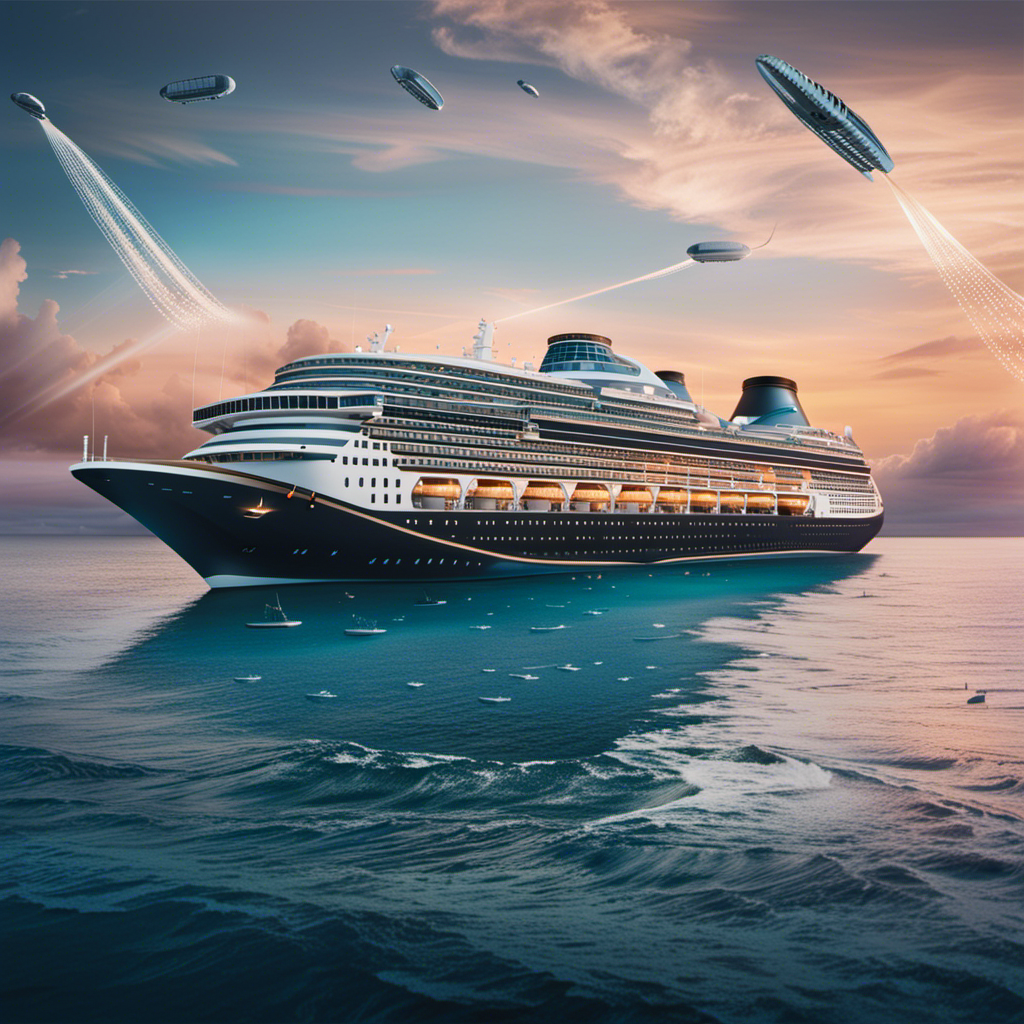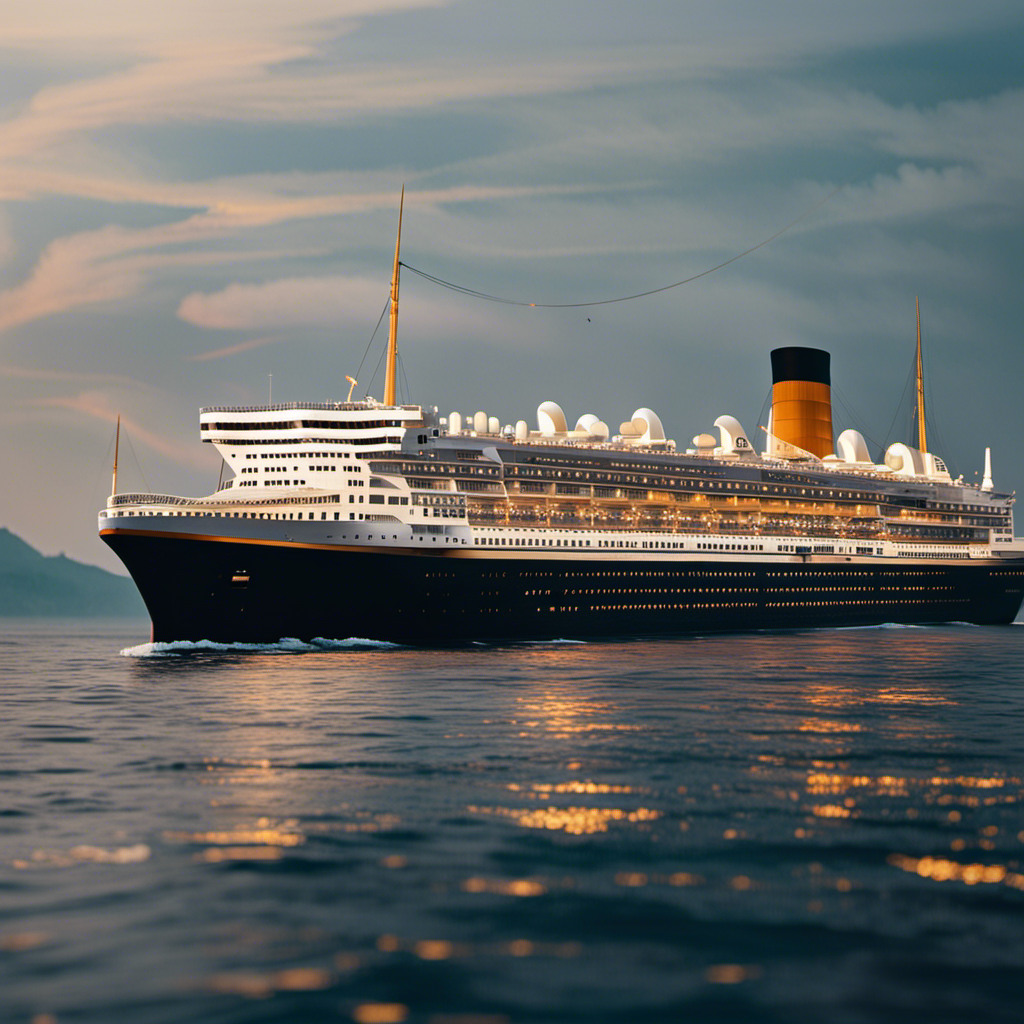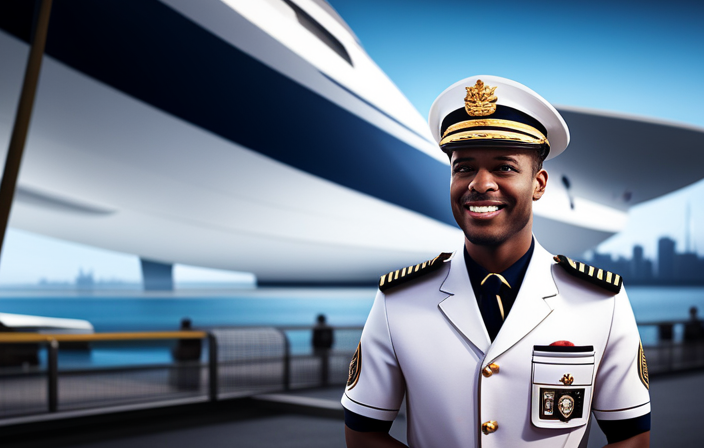As someone frequently on the move, I have always been fascinated by the challenge of staying connected when on a cruise. How do cell phones manage to work while out on the ocean?
In this article, we’ll delve into the technical intricacies of cell phone signal reception on cruise ships, the role of satellite communication systems, and the partnerships between cellular networks and cruise lines.
Join me on this journey as we explore the fascinating world of cell phone connectivity at sea.
Key Takeaways
- Cell phone signal on cruise ships relies on satellite technology for communication.
- Satellite coverage and reception determine the reach and signal pickup of satellites.
- Cell phone connectivity on cruise ships relies on satellite communication systems.
- Network coverage at sea varies based on cruise line and partnerships with cellular network providers.
The Basics of Cell Phone Signal Reception on Cruise Ships
To get a better understanding of how your cell phone works on a cruise ship, let’s first explore the basics of cell phone signal reception.
When you’re onboard a cruise ship, your cell phone signal is not directly connected to land-based cell towers. Instead, it relies on satellite technology for communication. Cruise ships utilize satellite communication systems to provide connectivity to their passengers.
These systems enable you to make and receive calls, send text messages, and access the internet while at sea. However, it’s important to note that international calling rates may apply when using your cell phone on a cruise ship, so it’s advisable to check with your service provider for any additional charges.
Now that we understand the basics of cell phone signal reception, let’s delve into understanding the role of satellite communication systems.
Understanding the Role of Satellite Communication Systems
When it comes to understanding satellite communication systems, there are three key points to consider.
Firstly, satellite coverage and reception refers to the geographical areas that satellites can reach and how well they can pick up signals.
Secondly, cell phone connectivity is the ability of cell phones to connect to these satellites and establish a communication link.
Lastly, signal strength limitations determine the maximum strength at which signals can be transmitted and received.
These factors play a crucial role in determining the effectiveness and reliability of satellite communication systems.
Satellite Coverage and Reception
You might be wondering how cell phones work on cruise ships with satellite coverage and reception. Well, let me break it down for you.
When it comes to cell phone technology on a cruise ship, it relies heavily on satellite communication systems to provide connectivity. Here’s a visual representation of how it works:
- The cell phone connects to the ship’s mobile network, just like it would on land.
- The ship’s mobile network then uses a satellite communication system to establish a connection with the outside world.
- The satellite acts as a relay, transmitting the signals between the ship and the land-based mobile network.
This intricate system allows cell phones on cruise ships to have access to voice calls, text messages, and even internet data. It’s important to note that the quality of the connection can vary depending on the ship’s location and the strength of the satellite signal.
Now, let’s dive into the next section and explore the fascinating world of cell phone connectivity at sea.
Cell Phone Connectivity
Cell phone connectivity on cruise ships relies on satellite communication systems to establish a connection with the outside world. These systems enable passengers to make calls, send text messages, and access the internet while at sea.
However, due to the unique challenges of being on a moving vessel, maintaining a reliable cell phone signal can be problematic. To address this issue, some cruise ships are equipped with cell phone signal boosters, which amplify the weak signals received from the satellite. These boosters help to improve signal strength and ensure a more stable connection for passengers.
Additionally, satellite internet is another technology employed on cruise ships to provide internet access. It uses satellite communication to establish a connection with the internet, allowing passengers to browse the web and stay connected with their loved ones.
Despite these advancements, there are still limitations in signal strength that need to be considered.
Signal Strength Limitations
Satellite communication systems on cruise ships can face challenges with signal strength, impacting your ability to make calls and access the internet. Due to the ship’s movement and the distance from land-based satellite stations, signal interference can occur, leading to dropped calls and slow internet speeds.
This can be frustrating for passengers who rely on their cell phones for communication and staying connected. However, cruise lines are aware of this issue and have implemented alternative communication methods to improve the overall experience for passengers.
For example, some ships offer Wi-Fi calling and texting services, which utilize the ship’s own network to bypass satellite communication. Additionally, cruise lines are exploring cellular network partnerships to provide better coverage and faster speeds for their passengers, ensuring a seamless connection throughout their voyage.
Exploring Cellular Network Partnerships With Cruise Lines
When it comes to network coverage at sea, the availability and strength of cellular signals can vary greatly depending on the cruise line and the specific partnership they have with cellular network providers.
Roaming charges and fees are also an important consideration for travelers using their phones on a cruise ship. These charges can add up quickly, especially if you’re making calls, sending texts, or using data while at sea.
Network Coverage at Sea
To stay connected at sea, you’ll be pleased to know that network coverage on cruise ships can be quite reliable. Here’s what you need to know:
-
The network speed on cruise ships can vary depending on several factors, such as the location of the ship and the number of passengers using the network.
-
Most cruise lines have partnerships with multiple cellular network providers, allowing passengers to access international roaming services.
-
International roaming enables you to use your cell phone on the ship, just as you would on land, allowing you to make calls, send messages, and use data services.
-
It’s important to note that roaming charges and fees may apply when using your cell phone on a cruise ship, so it’s advisable to check with your cellular provider beforehand.
-
Some cruise lines also offer onboard Wi-Fi services, which can provide an alternative to using cellular networks.
When it comes to network coverage at sea, it’s crucial to understand the potential roaming charges and fees that may be incurred.
Roaming Charges and Fees
It’s important to be aware of the potential roaming charges and fees that may be incurred when using your cell phone on a cruise ship. While you may have an international calling plan, it’s crucial to understand that cruise ships operate on satellite networks, which can result in higher charges for making and receiving calls, sending texts, and using data services. These charges can quickly add up, especially if you are using your phone frequently. To help you visualize the potential costs, here is a breakdown of the roaming charges and fees that you may encounter on a cruise ship:
| Service | Roaming Charges |
|---|---|
| Calls | $2 per minute |
| Texts | $0.50 per message |
| Data | $10 per MB |
Now that you are aware of the potential charges, let’s explore some tips for enhancing cell phone reception at sea without incurring these fees.
Tips for Enhancing Cell Phone Reception at Sea
Improve your cell phone reception at sea by keeping your phone charged and close to a window.
In order to enhance your cell phone reception while cruising, there are a few tips you should keep in mind.
Firstly, make sure your phone is fully charged before setting sail, as a low battery can weaken the signal strength.
Secondly, try to position your phone near a window, as this can help improve reception by allowing the signal to reach your device more easily.
Additionally, if you are experiencing poor reception, you can try toggling the airplane mode on and off, as this can sometimes reset the connection.
Remember to troubleshoot common cell phone reception issues by checking your phone’s settings and ensuring that roaming is enabled.
By following these tips, you can maximize your chances of having a reliable cell phone signal while at sea.
When it comes to roaming charges and data plans, it is important to be aware of the potential costs and limitations.
Roaming Charges and Data Plans: What to Know Before You Sail
Before setting sail, it is essential to understand the potential costs and limitations of roaming charges and data plans. This will help you avoid any unexpected charges or service disruptions during your cruise. Here are some key points to consider:
-
Roaming charges: Check with your mobile service provider to understand the roaming charges applicable to your destination. These charges can vary significantly and may include fees for calls, texts, and data usage.
-
Data plans: Consider purchasing an international data plan from your provider before your trip. This can help you avoid excessive data charges and provide you with a more predictable cost for using data on your cruise.
-
Limitations: Keep in mind that the availability and speed of data can be limited while at sea. Your connection may be slower compared to on land, and certain services or apps may not work as efficiently.
-
Wi-Fi options: Look into the Wi-Fi options available on your cruise ship. Many ships offer Wi-Fi packages that can be more cost-effective than roaming charges. Additionally, using Wi-Fi calling and texting can help you stay connected without relying on your cellular network.
Understanding these aspects of roaming charges and data plans will help ensure a smooth and cost-effective communication experience during your cruise. Now, let’s explore how to stay connected on a cruise ship using Wi-Fi calling and texting.
Wi-Fi Calling and Texting: How to Stay Connected on a Cruise Ship
To stay connected on a cruise ship, you can use Wi-Fi calling and texting as an alternative to relying on your cellular network.
Wi-Fi calling allows you to make and receive calls over a Wi-Fi connection, rather than using your cellular network. This has several benefits, including the ability to make calls and send texts without incurring roaming charges or using your data plan.
Additionally, Wi-Fi calling often provides better call quality and coverage compared to cellular networks, especially in areas where the signal may be weak.
By utilizing Wi-Fi calling and texting, you can stay connected with friends and family back home, as well as communicate with fellow passengers on the ship.
As technology continues to advance, there will likely be even more alternatives to traditional cell phone usage on cruise ships.
Future Trends: Advances in Cellular Connectivity on Cruise Ships
In my previous discussion, I explained how Wi-Fi calling and texting can keep passengers connected while on a cruise ship. Now, let’s delve into the future trends of cellular connectivity on these ships and explore the advances in technology that will enhance the passenger experience.
Advances in technology are constantly transforming the way we stay connected at sea. Cruise ship operators are investing in advanced cellular networks and infrastructure to provide faster and more reliable connectivity. This includes the implementation of small cell technology, which increases network capacity and coverage, ensuring a seamless experience for passengers.
Furthermore, the introduction of 5G technology on cruise ships is set to revolutionize the passenger experience. With its faster speeds and lower latency, 5G will enable enhanced services such as virtual reality experiences, real-time streaming, and immersive gaming. Passengers will be able to stay connected with loved ones, access online entertainment, and explore new digital experiences, all while sailing the high seas.
These technological advancements in cellular connectivity will undoubtedly have a significant impact on the overall passenger experience, providing them with unparalleled connectivity and entertainment options during their cruise.
Frequently Asked Questions
Can I Use My Cell Phone on a Cruise Ship?
Yes, I can use my cell phone on a cruise ship. However, it depends on the cell phone coverage provided by the cruise ship. Roaming charges may apply, so it is important to check with my service provider beforehand.
How Does a Cell Phone Receive a Signal While at Sea?
When at sea, a cell phone receives a signal through a combination of factors such as cell tower proximity, antenna strength, and satellite connections. Weather conditions can impact cell phone signal strength, affecting reception quality.
Which Satellite Communication Systems Are Commonly Used on Cruise Ships?
Satellite communication technology is commonly used on cruise ships to provide cellular coverage at sea. One interesting statistic is that over 90% of cruise ships use satellite systems for communication, ensuring passengers stay connected while on board.
Do Cruise Lines Have Partnerships With Specific Cellular Networks?
Cruise lines usually partner with specific cellular networks to provide benefits like reduced roaming charges for their passengers. These partnerships ensure better connectivity and seamless communication while on board the ship.
What Can I Do to Improve My Cell Phone Reception While on a Cruise Ship?
To improve my cell phone reception on a cruise ship, I can take a few steps. First, I can try moving to an area with better signal strength. Additionally, I can use a signal booster or a Wi-Fi calling feature on my phone.
Conclusion
After diving into the intricacies of cell phone signal reception on cruise ships, I’ve come to a fascinating conclusion.
It seems that the theory of using satellite communication systems to boost cell phone reception is not entirely accurate. While these systems play a crucial role in connecting the ship to the outside world, they don’t directly enhance cell phone signals.
Instead, cruise lines rely on partnerships with cellular networks to provide coverage at sea. Understanding these partnerships and implementing tips for enhancing reception can greatly improve your communication experience on a cruise.
Alfons is the visionary leader and driving force behind Voyager Info’s success. As the Editor in Chief, he brings a wealth of experience and an unwavering passion for travel to the helm of our cruise-centric platform.
With a lifelong fascination for exploring new horizons, Alfons discovered his love for the ocean and cruising at a young age. From sailing across pristine Caribbean waters to embarking on daring expeditions to far-flung destinations, he has amassed a treasure trove of first-hand experiences in the world of cruising.











